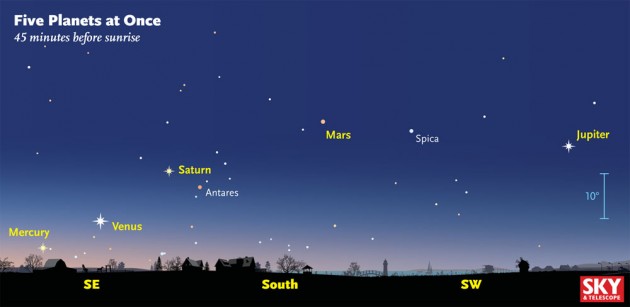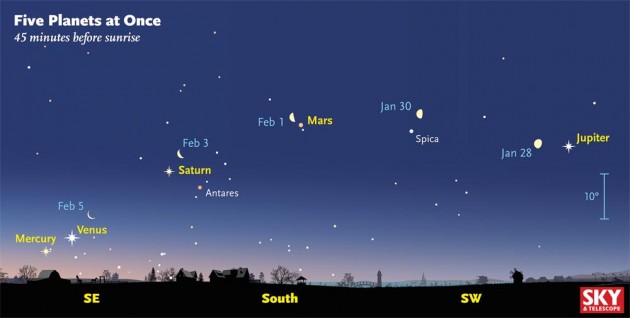
Get Up Early, See Five Planets at Once!
Over the next two weeks, for the first time in more than a decade, you can see all of the naked-eye planets — from Mercury to Saturn — together in the predawn sky.
If you follow celestial comings and goings at all, you know that bright planets have been largely missing from the evening sky for a few months. Sure, with careful watching you could have spotted Saturn low in the southwest as late as November, and Mercury put in a brief appearance a few weeks ago.
But really all the action has been in the sky before sunrise. Anchored by bright Venus and Jupiter, joined by Mars and Saturn, this planetary fab four has been dominating skywatchers’ attention for months. (Did you catch last October’s triple play involving Venus, Jupiter, and Mars?)
The show far from over. In fact, during the next two weeks you’ll have a good chance to view five planets at once. It’s a real visual treat, so don’t pass up the chance to see it.
(You might see posts elsewhere that suggest this event runs from January 20th to February 20th. Technically, that’s true — in his book More Mathematical Morsels, celestial dynamicist Jean Meeus notes these dates. But realistically you’re not going to see Mercury linger in the predawn sky for a whole month. Instead, I suggest that the last week of January and first week of February are your “best bets” for success.)
Let’s set the stage. You’ll need to be outside about 45 minutes before sunrise. This time of year, if you work or go to school, you’re usually already up by then — maybe even well positioned to scan the predawn eastern horizon as you commute to work or head off to school.
Here’s the view 45 minutes before sunrise as plotted for January 25th. With each passing day, Mercury will appear brighter and climb a little higher. Sky & Telescope diagram
Venus is obvious as it lingers above the southeastern horizon. It’s actually in decline, not nearly as high up as you saw it toward the end of 2015. But Venus has no equal for brightness among the night’s planets and stars. Way over to the right, on the southwestern side of the sky, is Jupiter. In between are four bright beacons: not far from Venus are Saturn and, below it, the star Antares. Shift your gaze farther right to sweep up Mars, then the star Spica, and finally Jupiter.
The fifth planet is Mercury, which was spotable low in the southwest after sunset just two weeks ago. But it’s been racing rapidly from evening to morning visibility. (The fleetest of planets can do that, since it circles the Sun in just 88 days.)
Your first good chance to spot Mercury before dawn comes later this week. By Friday, the 22nd, find a clear view toward southeast and look 5° above the horizon. That’s about the width of your three middle fingers held together at arm’s length. It’s along a diagonal from Saturn through Venus, about as far from Venus as Saturn is. Day by day, Mercury will appear a little higher up and a little brighter. By month’s end, it’ll be easy to spot.
Here’s the view 45 minutes before sunrise as plotted for February 1st, about when Mercury should be easiest to spot. For several days the waning Moon is marching eastward among the assembled planets.
Sky & Telescope diagram
A Plane of Planets
As you sweep your gaze from Mercury toward Jupiter, an arc of roughly 110°, notice that all these planets line along a single arc across the sky. That’s no accident. All of the major planets lie very near the plane of Earth’s orbit, which projects as a line — the ecliptic — across the sky. By defniition, the Sun always lies on the ecliptic — and our Moon is never far from it either. It’s the superhighway of planetary motion among the stars.
As you’re gazing at all these planets, think about their varied distances from us? Astronomers use the average Earth-Sun distance, called an astronomical unit, as a handy yardstick for intra-solar-system distances. Of the five planets you’re seeing, right now Mercury is closest (about 0.8 a.u.), followed by Venus (1.3), Mars (1.4), Jupiter (4.7) and Saturn (10.6). The reflected sunlight you see coming from mercury took a brief 6½ minutes to reach Earth, where that from Saturn took just under 1½ hours to get here.
But don’t let the vastness of interplanetary space keep you from enjoying for the simple visual beauty that awaits you before dawn. We haven’t had this opportunity since this time 11 years ago. Back then their order in the sky briefly matched their relative order outward from the Sun. This time, Mars and Saturn apparently didn’t get the memo, but we’ll happily overlook that, right?


